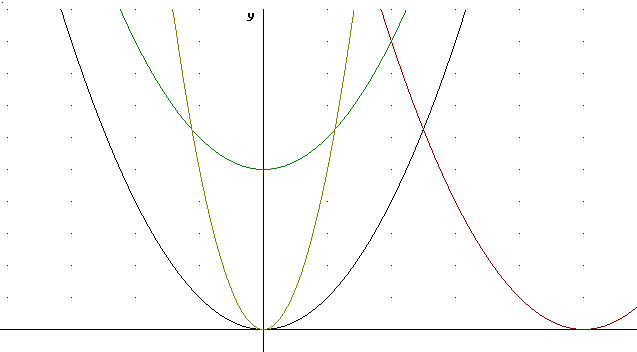
040205
If g(t) = t^2 then give the t values for which g would be applied to arguments -1, 0 and 1, the y values taken at each argument, and the corresponding points on a graph of y vs. t:
The 'argument' of this function is t - 3.
If g is applied to argument -1, then t - 3 = -1 so that t = 2. The corresponding graph point is (2, 1).
If g is applied to argument 0, then t - 3 = 0 so that t = 3. The corresponding graph point is (3, 0).
If g is applied to argument 1, then t - 3 = 1 so that t = 4. The corresponding graph point is (4, 1).
In terms of a table, we see that the value of t is 3 greater than the value of the argument, which is why g(t-3) is shifted +3 units in the t direction:
|
t |
argument t-3 |
g(t-3) |
|
2 |
-1 |
1 |
|
3 |
0 |
0 |
|
4 |
1 |
1 |
Similarly the argument is t + 5 so the value of t is 5 less than that of the argument. So the graph of g(t+5) will be shifted -5 units from the graph of g(t).
|
t |
argument t+5 |
g(t+5) |
|
-6 |
-1 |
1 |
|
-5 |
0 |
0 |
|
-4 |
1 |
1 |
The 'argument' of this function is t + 5.
If g is applied to argument -1, then t + 5 = -1 so that t = -6. The corresponding graph point is (-6, 1).
If g is applied to argument 0, then t + 5 = 0 so that t = -5. The corresponding graph point is (-5, 0).
If g is applied to argument 1, then t + 5 = 1 so that t = -4. The corresponding graph point is (-4, 1).
The 'argument' of this function is t - 12.
If g is applied to argument -1, then t - 12 = -1 so that t = 11. The corresponding graph point is (11, 1).
If g is applied to argument 0, then t - 12 = 0 so that t = 12. The corresponding graph point is (12, 0).
If g is applied to argument 1, then t - 12 = 1 so that t = 13. The corresponding graph point is (13, 1).
If g(t) = t^2 then give the vertical stretch, the horizontal shift and the vertical shift required to obtain each of the following from the graph of y = t^2. Also give the points to which would the three points (-1, 1), (0, 0) and (1, 1) on the y = t^2 graph be transformed at each stage by each of the functions?
The y values of 5 t^2 are 5 times as great as the y values of g(t) = t^2, so the graph of 5 t^2 is vertically stretched by factor 5.
So y = 5 t^2 can be represented by the function 5 * g(t).
The basic points (-1, 1), (0, 0) and (1, 1) are transformed to (-1, 5), (0, 0) and (1,5).
t^2 + 5 is g(t) + 5.
This function lies 5 units higher than that of g(t) = t^2.
This represents a vertical shift by factor 5.
The basic points (-1, 1), (0, 0) and (1, 1) are transformed to (-1, 6), (0, 5) and (1,6).
This is g(t-5).
The argument is 5 less than t so t is 5 greater than the argument. This shifts everything +5 units in the t direction.
The basic points (-1, 1), (0, 0) and (1, 1) are transformed to (4, 1), (5, 0), (6, 1).
This is g(t+5).
The argument is 5 greater than t so t is 5 less than the argument. This shifts everything -5 units in the t direction.
The basic points (-1, 1), (0, 0) and (1, 1) are transformed to (-6, 1), (-5, 0), (-4, 1).
The figure below depicts g(t), g(t)+5, 5 g(t) and g(t-5).

This can be expressed as 5 g(t) + 3.
The first thing that happens is the vertical stretch by factor 5.
The basic points (-1, 1), (0, 0) and (1, 1) are transformed by the vertical stretch to (-1, 5), (0, 0) and (1, 5).
Then we vertically shift 3 units, which transforms the basic points we got from the preceding step to (-1, 8), (0, 3) and (1, 8).
The figure below depicts the graphs of g(t), 5 g(t) and 5 g(t) + 3.
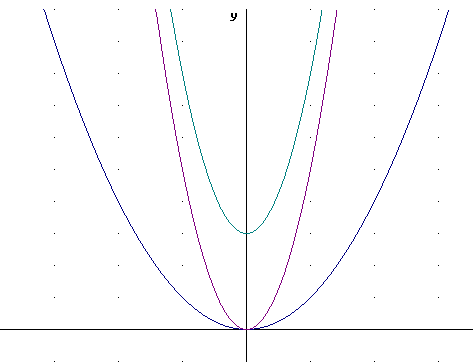
First apply the -5, which shifts every point 5 units to the right.
The basic points (-1, 1), (0, 0) and (1, 1) are transformed by this horizontal shift to (4, 1), (5, 0) and (6, 1). The function at this point is g(t-5).
Then apply the 2, which vertically stretches the graph so that the preceding basic points become (4, 2), (5, 0) and (6, 2).
The function we end up with is 2 g(t-5).
The figure below depicts g(t), g(t-5) and 2 g(t-5).
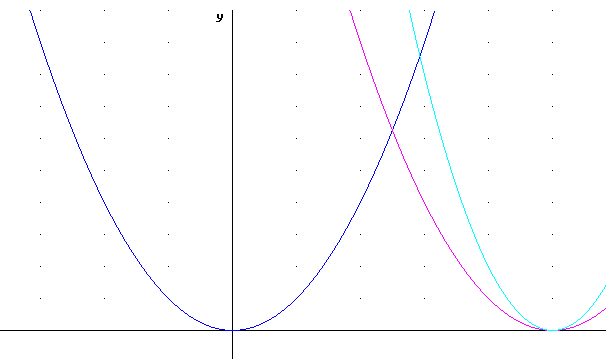
This function shifts 2 units in the t direction, then stretches by factor 3 then shifts +5 units in the vertical direction.
The function is 3 g(t) + 5.
Basic points go from (-1, 1), (0, 0), (1, 1) to (1, 1), (2, 0), (3, 1) to (1, 3), (2, 0), (3, 3) and finally to (1, 8), (2, 5), (3, 8).
The graphs of the original, intermediate and final functions are shown below:
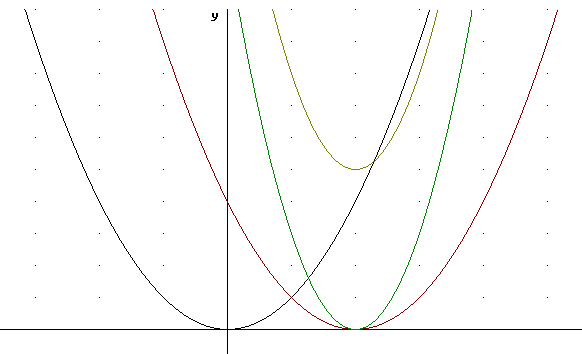
If h(t) = 2^t then give the t = -1, t = 0 and t = 1 points of the following, and graph the points:
The points are just (-1, 1/2), (0, 1) and (1, 2).
The three points (-1, 1/2), (0, 1) and (1, 2) of the h(t) function are vertically stretched by factor 2 to give us (-1, 1), (0, 2) and (1, 4).
The three points (-1, 1/2), (0, 1) and (1, 2) of the h(t) function are vertically stretched by factor .1 to give us (-1, .05), (0, .1) and (1, .2).
The three points (-1, 1/2), (0, 1) and (1, 2) of the h(t) function are vertically shifted +4 units to give us (-1, 4.5), (0, 5) and (1, 6).
The three points (-1, 1/2), (0, 1) and (1, 2) of the h(t) function are first vertically stretched by factor 2 to give us (-1, 1), (0, 2) and (1, 4).
Then the points are vertically shifted +4 units to give us (-1, 5), (0, 6) and (1, 8).
The three points (-1, 1/2), (0, 1) and (1, 2) of the h(t) function are first vertically stretched by factor .1 to give us (-1, .05), (0, .1) and (1, .2).
Then the points are vertically shifted +4 units to give us (-1, 4.05), (0, 4.1) and (1, 4.2).
What are the functions that go with each of the preceding transformations?
If h(t) = 2^t then give the t values for which g would be applied to arguments -1, 0 and 1, the y values taken at each argument, and the corresponding points on a graph of y vs. t:
The 'argument' of this function is t - 3.
If h is applied to argument -1, then t - 3 = -1 so that t = 2. The corresponding graph point is (2, 1/2).
If h is applied to argument 0, then t - 3 = 0 so that t = 3. The corresponding graph point is (3, 1).
If h is applied to argument 1, then t - 3 = 1 so that t = 4. The corresponding graph point is (4, 2).
In terms of a table, we see that the value of t is 3 greater than the value of the argument, which is why h(t-3) is shifted +3 units in the t direction:
|
t |
argument t-3 |
h(t-3) |
|
2 |
-1 |
1/2 |
|
3 |
0 |
1 |
|
4 |
1 |
2 |
Similarly the argument is t + 5 so the value of t is 5 less than that of the argument. So the graph of h(t+5) will be shifted -5 units from the graph of h(t).
|
t |
argument t+5 |
h(t+5) |
|
-6 |
-1 |
1/2 |
|
-5 |
0 |
1 |
|
-4 |
1 |
2 |
The 'argument' of this function is t + 5.
If g is applied to argument -1, then t + 5 = -1 so that t = -6. The corresponding graph point is (-6, 1/2).
If g is applied to argument 0, then t + 5 = 0 so that t = -5. The corresponding graph point is (-5, 1).
If g is applied to argument 1, then t + 5 = 1 so that t = -4. The corresponding graph point is (-4, 2).
The 'argument' of this function is t - 12.
If h is applied to argument -1, then t - 12 = -1 so that t = 11. The corresponding graph point is (11, 1/2).
If h is applied to argument 0, then t - 12 = 0 so that t = 12. The corresponding graph point is (12, 1).
If h is applied to argument 1, then t - 12 = 1 so that t = 13. The corresponding graph point is (13, 2).
If h(t) = 2^t then give the vertical stretch, the horizontal shift and the vertical shift required to obtain each of the following from the graph of y = 2^t. Show also the sequence of transformations of the t = -1, 0, 1 points of the original h(t) vs. t graph:
The y values of 5 *2^t are 5 times as great as the y values of h(t) = 2^t, so the graph of 5 * 2^t is vertically stretched by factor 5.
So y = 5 * 2^t can be represented by the function 5 * h(t).
The basic points (-1, 1/2), (0, 1) and (1, 2) are transformed to (-1, 2.5), (0, 5) and (1,10).
2^t + 5 is h(t) + 5.
This function lies 5 units higher than that of h(t) = 2^t.
This represents a vertical shift by factor 5.
The basic points (-1, 1/2), (0, 1) and (1, 2) are transformed to (-1, 5.5), (0, 6) and (1,7).
The figure below depicts the graphs of h(t) and 5 h(t)
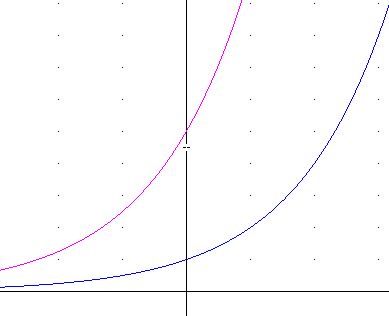
This is h(t-5).
The argument is 5 less than t so t is 5 greater than the argument. This shifts everything +5 units in the t direction.
The basic points (-1, 1/2), (0, 1) and (1, 2) are transformed to (4, 1/2), (5, 1), (6, 2).
The figure below depicts h(t) and h(t-5).

This is h(t+5).
The argument is 5 greater than t so t is 5 less than the argument. This shifts everything -5 units in the t direction.
The basic points (-1, 1/2), (0, 1) and (1, 2) are transformed to (-6, 1/2), (-5, 1), (-4, 2).
The figure below depicts h(t) and h(t+5).
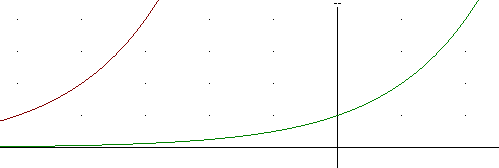
This can be expressed as 5 h(t) + 3.
The first thing that happens is the vertical stretch by factor 5.
The basic points (-1, 1/2), (0, 1) and (1, 2) are transformed by the vertical stretch to (-1, 5), (0, 0) and (1, 5).
Then we vertically shift 3 units, which transforms the basic points we got from the preceding step to (-1, 8), (0, 3) and (1, 8).
The figure below depicts the graphs of h(t), 5 h(t) and 5 h(t) + 3.
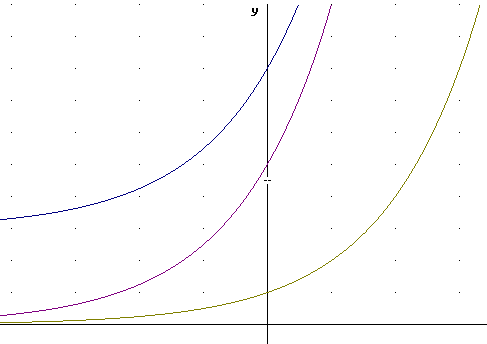
First apply the -5, which shifts every point 5 units to the right.
The basic points (-1, 1/2), (0, 1) and (1, 2) are transformed by this horizontal shift to (4, 1), (5, 0) and (6, 1). The function at this point is h(t-5).
Then apply the 2, which vertically stretches the graph so that the preceding basic points become (4, 2), (5, 0) and (6, 2).
The function we end up with is 2 h(t-5).
The figure below depicts h(t), h(t-5) and 2 h(t-5).

This function shifts 2 units in the t direction, then stretches by factor 3 then shifts +5 units in the vertical direction.
The function is 3 h(t) + 5.
Basic points go from (-1, 1), (0, 0), (1, 1) to (1, 1), (2, 0), (3, 1) to (1, 3), (2, 0), (3, 3) and finally to (1, 8), (2, 5), (3, 8).
The graphs of the original, intermediate and final functions are shown below:
